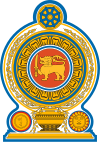Sri Lanka–United States relations
This article needs to be updated. (November 2015) |
 | |
Sri Lanka |
United States |
|---|---|
Sri Lanka – United States relations are bilateral relations between Sri Lanka and the United States.
In a 2005 BBC World Service Poll, 30% of Sri Lankans view American influence positively, with 20% expressing a negative view.[1] According to the 2012 U.S. Global Leadership Report, 14% of Sri Lankans approve of U.S. leadership, with 37% disapproving and 49% uncertain.[2]
History

The United States enjoys cordial relations with Sri Lanka that are based, in large part, on shared democratic traditions. U.S. policy toward Sri Lanka is characterized by respect for its independence, sovereignty, and moderate nonaligned foreign policy; support for the country's unity, territorial integrity, and democratic institutions; and encouragement of its social and economic development. The United States is a strong supporter of ethnic reconciliation in Sri Lanka and the peace process that began in December 2001.

U.S. assistance has totaled more than $2 billion since Sri Lanka's independence in 1948.[3] Through the U.S. Agency for International Development (USAID), it has contributed to Sri Lanka's economic growth with projects designed to reduce unemployment, improve housing, develop the Colombo Stock Exchange, modernize the judicial system, and improve competitiveness.[4] At the June 2003 Tokyo Donors' Conference on Sri Lanka, the United States pledged $54 million, including $40.4 million of USAID funding. Following the 2004 tsunami, the United States provided $135 million in relief and reconstruction assistance.[5] In addition, the International Broadcasting Bureau (IBB) operates a radio-transmitting station in Sri Lanka.[3]
Under president Mahinda Rajapaksa relations with the US were strained but the ties improved after the unity government of President Maithripala Sirisena and Prime Minister Ranil Wickremesinghe came to power in 2015. In May 2015, US Secretary of State John Kerry visited Sri Lanka for an official tour. US Counsellor of the State Department Thomas Shannon visited Sri Lanka in December 2015 where the first US-Sri Lanka partnership dialogue to improve Governance, Development Cooperation and People-to-People ties; Economic Cooperation; Security Cooperation and International and Regional Affairs was announced and US offered assistance to help Sri Lanka become an economic and strategic hub in the Indian Ocean region.[6]
Principal U.S. Embassy Officials include:
- Ambassador – Atul Keshap[7]
- Deputy Chief of Mission – Andrew C. Mann
- Head of Political Section – Michael DeTar
- Head of Economic/Commercial Section – Robert Gabor
- Management Officer – Maria Brewer
- Consular Officer – Joel Weigert
- Defense Attaché – Lt. Col. Lawrence A. Smith III
- Director, USAID – Rebecca Cohn
- Public Affairs Officer – Jeff Anderson
- IBB Station Manager – William Martin
The U.S. Embassy in Sri Lanka is located in Colombo, as are U.S. Agency for International Development offices and Public Affairs offices. IBB offices are located near Chilaw, 75 km north of Colombo.
Defence Relations
The U.S. Armed Forces maintain a limited military-to-military relationship with the Sri Lanka defense establishment.[3] United States and Sri Lanka started to enhance defence relations beyond the sale of military equipment, and training facilities were extended when Sri Lanka was in an internal battle with a secessionist movement Tamil Tigers. It was reported that the US Navy Pacific Command provided intelligence for the Sri Lankan government during the civil war to hunt down LTTE crews and four ships. This was later confirmed by the former president Mahinda Rajapaksa who's government was hostile to the United States.[8][9][10][11]
See also
- Sri Lankan Americans
- Foreign relations of Sri Lanka
- Foreign relations of the United States
- United States Ambassador to Sri Lanka
References
- ^ [1] BBC World Service
- ^ U.S. Global Leadership Project Report - 2012 Gallup
- ^ a b c "U.S. Relations With Sri Lanka". U.S. Department of State. Retrieved 22 July 2015.
- ^ "Humanitarian Assistance". USAID. Retrieved 22 July 2015.
- ^ Gamage, Daya. "US Tsunami aid to Sri Lanka for 2005 tops $135 million". Asian Tribune. Retrieved 22 July 2015.
- ^ [2] Reuters
- ^ http://srilanka.usembassy.gov/ambassador.html
- ^ "U.S. wants 'enhanced' military relations with Sri Lanka | Asian Tribune". asiantribune.com. Retrieved 25 November 2015.
- ^ "India, US gave navy intelligence to fight the LTTE | Colombo Gazette". Retrieved 4 December 2015.
- ^ "US helped destroy some LTTE 'floating arsenals'-President".
- ^ "US Navy's Pacific Command behind destruction of LTTE".
![]() This article incorporates public domain material from U.S. Bilateral Relations Fact Sheets. United States Department of State.[3]
This article incorporates public domain material from U.S. Bilateral Relations Fact Sheets. United States Department of State.[3]

